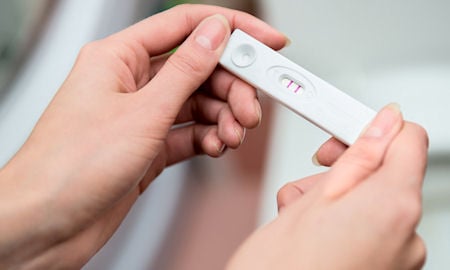
ART Medications
Several medications are used in a typical IVF cycle. These medicines belong to several categories and each are an important part of a stimulated cycle. The types and amount of medications used vary according to the medication protocol prescribed by your physician.
GnRH Agonists
Gonadotropin releasing hormone (GnRH) is a hormone produced in the brain that indirectly stimulates ovarian function. Agonists of GnRH are synthetic forms of this hormone which do not directly induce follicle development or ovulation but which have become very important in ART therapy.
There are several advantages to using GnRH agonists:
- They make ovarian stimulation easier to regulate, since the patient's own hormone production is suppressed.
- Patients who are treated with GnRH agonists tend to produce a greater proportion of mature oocytes than patients who do not receive them.
- GnRH agonists markedly decrease the risk of cycle cancellation for most patients. Prior to their use, 20-50 percent of IVF-ET cycles were canceled because patients would have a premature LH surge with spontaneous ovulation. Using GnRH agonists, the risk of cycle cancellation is less than 5 percent.
- Ovarian function can be suspended with GnRH agonists for variable periods of time if necessary, which allows for flexibility in cycle scheduling.
Mechanism Of Action
Agonists of GnRH (such as Lupron®) initially stimulate the pituitary gland to release all the stored gonadotropins (LH and FSH -the hormones that normally stimulate ovarian function). Over the course of a week to 10 days, GnRH analogs suppress the production of any new LH and FSH. This effect appears to prevent the ovaries from receiving mixed signals from the patient's own LH and FSH and from the medications that are administered to stimulate follicle development. The result for many patients is a more synchronized development of mature oocytes.
Dosage and Monitoring
The GnRH agonist used most commonly is leuprolide acetate (Lupron®). Lupron® is not FDA approved for use in IVF treatment but has been used successfully in IVF for 20 years. Lupron® must be injected to be active. In ART therapy, a formulation of Lupron® is used, which can be injected just under the skin, in a manner similar to insulin injections for diabetes therapy.
The usual dosage of Lupron® is 0.1 or 0.2 cc daily as a single injection. Menstruation usually occurs four to 10 days later. During the time of actual ovarian stimulation, the dosage of Lupron® is halved (e.g., 0.1 cc to 0.05 cc daily). Lupron is usually administered until the day of hCG administration. Some patients, because of their history or condition, are treated with a different dosage or schedule of Lupron®.
In some protocols, a GnRH analog can be used to trigger ovulation of mature follicles in place of human chorionic gonodpotropin. This is usually reserved for patients with a risk of hyperstimulation.
Another GnRH analog used in ART therapy is nafarelin acetate (Synarel®). Synarel® is administered as a nasal spray. The usual starting dose is two sprays twice a day. The timing of administration is identical to Lupron®. The dosage of Synarel® is usually halved (e.g., from two sprays twice a day to one spray twice a day) when ovarian stimulation is begun.
GNRH Antagonists
Antagonists of GnRH are also available (Cetrotide® and Antagon®). These are started later in the cycle than Lupron® and directly and immediately inhibit FSH and LH production. Protocols that use these medications may require fewer injections. Ultrasound measurements of follicular growth are used to determine when to start these medicines.
Mechanism of Action
GnRH antagonists bind to the receptor for gonoadotropin releasing hormone on the pituitary, preventing the natural luteinizing hormone surge and ovulation. This is important to the success of an IVF cycle, when premature ovulation could reduce the number of oocytes retrieved.
Gonadotropins
To increase likelihood of pregnancy through ART, multiple oocytes must be produced. This is accomplished through the administration of gonadotropins, hormonal medications that directly stimulate the ovaries. Stimulation can be achieved with a variety of drug regimens. Gonadotropin medications come in several forms; Repronex® and Menopur® are a combination of FSH and LH. They replace a woman's own LH and FSH which are normally produced by the pituitary gland. Bravelle®, Follistim® AQ Cartridge for use with Follistim Pen®, Follistim® AQ Vial, Gonal-F®, and Gonal-F® RFF Pen are preparations that contain only FSH. Follistim® AQ Cartridge for use with Follistim Pen®, Follistim® AQ Vial, Gonal-F®, and Gonal-F® RFF Pen are recombinant products which are made by genetically engineered cells. This process ensures uniform purity and potency. Because the dose of hormones that are used in ART is greater than what the body normally produces, the ovaries typically develop more than one oocyte as occurs in a natural cycle.
Gonadotropins act directly on the ovary to stimulate the growth of follicles (the structures in the ovaries which contain eggs). Granulosa cells within the follicles grow and develop which cause the follicles to enlarge and fill with follicular fluid. These developing follicles can be counted and measured using transvaginal ultrasound. As the follicles grow, they produce increasing amounts of estrogen, which can be measured with a laboratory blood test. Some physicians prefer one formulation or another. Your doctor can discuss this with you in more detail.
Dosage and Monitoring
Gonadotropins are packaged in vials containing 37.5, 75 or 150 International Units (IU). Follistim AQ Pens and Gonal-F RFF Pens are packaged in pre-mixed injectable pens. Multi-dose vials of some medications are also available. Dosage may vary depending on the patient's history. Patients will then have regularly scheduled transvaginal ultrasound examinations and serum estradiol tests. The dose of gonadotropins is then determined by the result of the ultrasound and estradiol tests. Most women require between seven to 10 days of gonadotropin therapy.
Bravelle®, and Repronex® are administered subcutaneously or by intramuscular injection, usually into the muscles of the buttocks. Gonal-F,® Follistim,® Follistim AQ Pens, and Gonal-F RFF Pens are administered subcutaneously, like an insulin or allergy shot.
Human Chorionic Gonadotropin
Human chorionic gonadotropin (hCG) is an injectable medication that is administered to complete oocyte maturation. The brand names for hCG are Profasi®, Ovidrel®, Novarel®,and Pregnyl®.
Mechanism of Action
Human chorionic gonadotropin is structurally similar to the LH that is produced by a woman's pituitary gland. It acts on the ovary in a manner similar to a woman's own LH. Human chorionic gonadotropin, like LH, stimulates the final maturation of the oocytes in the follicle. It also stimulates progesterone production from the ovary after egg retrieval. This progesterone is important to prepare the uterus for implantation of the embryo.
Dosage and Administration
Human chorionic gonadotropin can be administered several different ways. The commonly administered dose is a single injection of 10,000 units. Once hCG is administered, ovulation usually occurs in approximately 36 to 40 hours. Therefore oocyte retrieval is routinely scheduled at 34-36 hours after hCG. This helps ensure maximal egg maturity, which is important for fertilization and embryo development. Occasionally, several doses of 2,500 units (usually every three days) are administered after egg retrieval to stimulate progesterone production. If your response to stimulation is particularly exuberant, the dose of hCG can be reduced to 5,000 units in an attempt to reduce the risk of ovarian hyperstimulation syndrome.
It typically takes 8-10 days for single injection of 10,000 units of hCG to be cleared from the blood stream. As hCG is the same hormone that is produced by a developing pregnancy, patients should not have a blood or urine pregnancy test sooner than 10 days following the hCG injection. If a pregnancy test is performed earlier, it may measure the hCG that was given by injection rather than measure hCG produced by a pregnancy.

